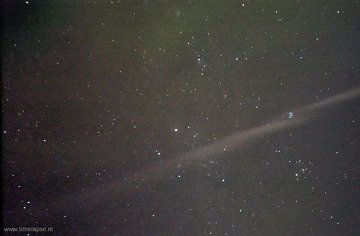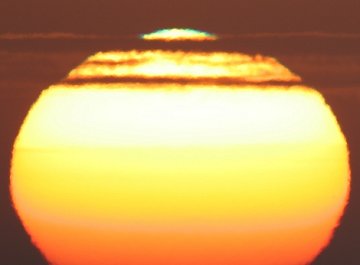 The space shuttle flies in April. Would you like a call when it soars over your backyard? Spaceweather PHONE!
The space shuttle flies in April. Would you like a call when it soars over your backyard? Spaceweather PHONE!
PLUTO OCCULTATION: On Sunday morning, March 18th, Pluto will pass directly in front of a star in the constellation Sagittarius. This occultation will be visible through large backyard telescopes in the western United States, offering a rare look into Pluto's surprising atmosphere. Experienced amateur astronomers are encouraged to observe.
PROTON AURORAS: A solar wind stream is buffeting Earth's magnetic field this week. On March 13th it produced a rare type of aurora over the Swedish Lapland: "A thin proton arc formed overhead," reports Jan Lameer. "The arc grew diffuse after ten minutes and remained visible for about an hour."

Photo details: Nikon D1H, 14mm lens, f/2.8, ISO 1600, 8 seconds.
Ordinary auroras are caused by electrons from space crashing down upon Earth's atmosphere. Air molecules of oxygen and nitrogen glow green, red and blue when subjected to the bombardment.
Proton auroras share the same underlying physics: Air molecules are bombarded from above, but in this case the "bombardiers" are protons. Compared to electrons, protons are not as tightly guided by Earth's magnetic field. While electrons produce crisp waves and curtains of light, protons yield more diffuse auroras often overlooked by sky watchers. Good catch, Jan!
March 2007 Aurora Gallery
[aurora alerts] [night-sky cameras]
TURQUOISE SUNRISE: On March 10th in Borken, Germany, photographer Günther Strauch woke up early to enjoy the sunrise--and he's glad he did. The rising sun let loose a cascade of green, blue and turquoise flashes. "Very nice!" he says.

Photo details: Canon EOS 20D, 1/160 to 1/4000 sec exposure, 100 ASA.
"There is a lot going on in this sunrise," explains atmospheric optics expert Les Cowley. "The color bands across the disk show that we are seeing it through multiple layers of air with temperature inversions. As the top of the sun rises through each layer, light from the edge is miraged and vertically magnified into green and blue flashes."
"The green flash of folklore happens once at an ocean surface. This one, a mock-mirage, can be seen flashing several times as the sun rises." More images: #1, #2, #3, #4.

